Lenovo W701 laptop or Why do I need a steam locomotive at home
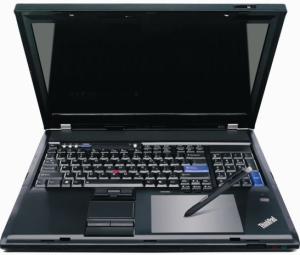 Notebook Lenovo W701 - very large. And heavy. And dear. On this, his serious shortcomings end and only virtues remain.
Notebook Lenovo W701 - very large. And heavy. And dear. On this, his serious shortcomings end and only virtues remain. By the time the Intel Core i3 / i5 / i7 processors were released, Lenovo had run in two new series - Edge and W. Edge - this was a purely consumer line, so to speak, Lenovo's entry into the consumer goods market. IBM has always positioned its laptops as purely corporate - hence the inflated price and rigorous design, and a completely killer standard guarantee that other manufacturers cost more than a hundred dollars extra. Accordingly, a series of Thinkpad Edge was needed to turn to a more massive buyer face. Because in the IdeaPad series, the mass buyer doesn’t really believe something.
With the W series, it was not entirely clear from the very beginning, because there were also the A series (desktop replacement) and the R series, which differed little in components from the T series (in the sense that about 70% of the components were interchangeable). However, with the release of the W701, everything fell into place - almost no series even comes close to specifications. Simply put - it’s as if for a horse competition in some 19th century (which could carry about the same load - some a little more, some a little less) someone would put a steam locomotive with a dozen freight cars.
So, we will understand - why do I need a steam locomotive in the house?
The system that I built for myself (4323-CTO) still boasts the following:
- Intel Core i7 Q820 1.73GHz
- 8GB 1067MHz RAM with expandability up to 16 GB 1333MHz
- 320 GB 7200 rpm Seagate disk, slot for a second HDD (now there is a Hitachi 7K200-100 200GB disk) and an optical DVD-RAM drive
- 17-inch screen 1920x1200 with LED- backlight (WUXGA RGB-LED-BL) and NVIDIA Quadro FX 2800M graphics card with 1 GB of memory
- Pantone hueyPro calibrator
- built-in webcam (Ricoh)
- trackpad ( aka red pimp) and touchpad (which I do not use), as well as an additional unit numeric keypad
- Wacom tablet with stylus
- card readers for CompactFlash and SD cards
- 5 USB-slots and one slot a FireWire
- video outputs VGA, DVI and the DisplayPort
- fingerprint pas tsev
- bulky power supply the size of a netbook
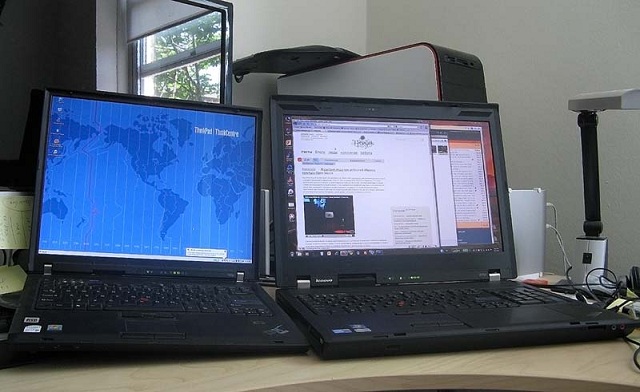
For the past 6 years, I used the T series, so it was a little unusual to realize that the size of the working computer has changed a lot. Now it’s quite problematic to take it with you “to the field” - it’s hard, and the battery does not last more than an hour and a half with more or less intensive use, and it does not fit into any of my backpacks W701. However, lately I’ve completely spilled out and haven’t been working for hours at Starbucks. Regarding the battery, I consider it necessary to add that in the W701 the battery is inserted into the case under the keyboard (as it was in the T23 model, if anyone remembers), which automatically means that it is impossible to have batteries of different capacities. As I understand it, this is necessary to give stability to the entire system with a high and heavy 17-inch screen.
The keyboard on the W701 is one of the best Lenovo keyboards I've ever seen. Most recently, I touched a little keyboard on the new T400 and was already disappointed in quality. However, the W701 quickly regained its calm. To my considerable surprise, the additional numeric keypad on the right not only does not interfere, but also turns out to be very useful.
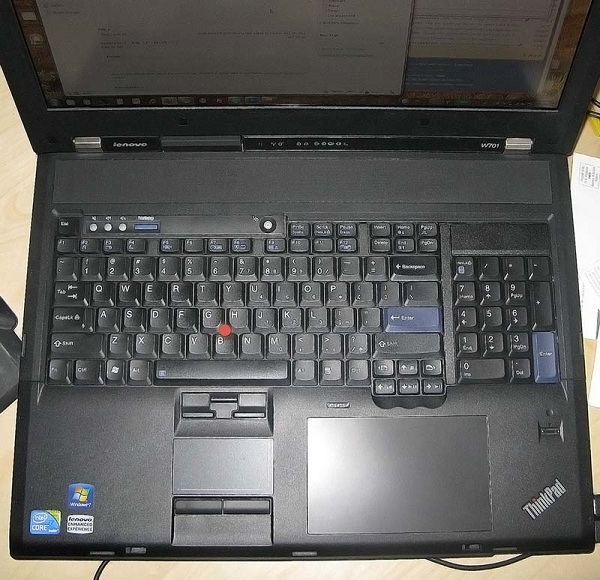
The tablet also turned out to be a funny story. At first I thought that he would just take up space. Since I don’t know how to draw at all, but to get a laptop with hueyPro, but without a tablet it was not possible - I just put up with its presence. However, just a couple of days after the laptop arrived, I urgently needed to send some signed papers by fax. I’ve had ten years as a fax, so I’ve bargained for sending pictures by e-mail. Previously, the process looked like this - print out documents on paper, sign with a pen, scan, send, discard the printout. If you have a style and a tablet - just signed with a style on the tablet in the right place - and you're done. Progress and undoubted saving of paper. Here is another example of using the style for the purpose of a blog:
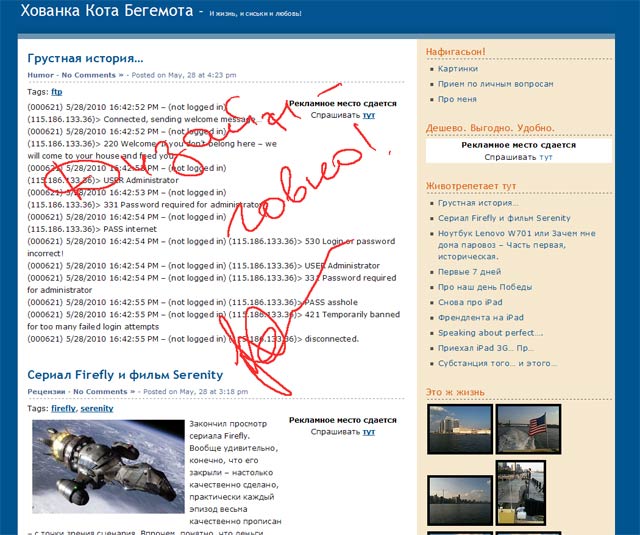
Continuing the conversation about laptop geometry - the power connector and all video outputs are displayed on the back wall. This arrangement has its drawbacks, but on the other hand it does not make the laptop even more clumsy, as was the case with the T60, which had a VGA connector on the side panel. Although with such a high-quality 17-inch screen, the need for a second monitor is rather doubtful, but for programmers and designers (who, in fact, need such a powerful set), this will not be superfluous. There are VGA, DVI and DisplayPort outputs, but the NVIDIA Quadro FX 2800M with a gigabyte of memory on board only supports two displays, so you can connect only one external monitor if you leave the laptop screen working, or two if you turn off the laptop screen.
After the T series, it’s very unusual to see a wide frame around the screen. Technologically, this may be justified, but looking at it is not very pleasant. For comparison - here is a photo with the T60p and W701 frames nearby:
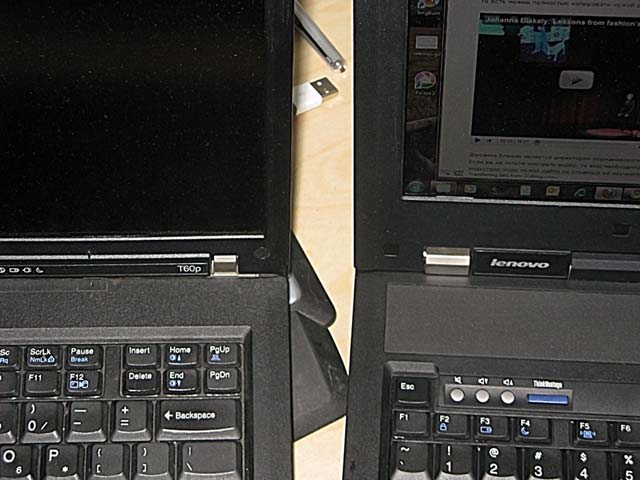
And the last thing about geometry is about the power supply. With the power supply - another story about how the power of the previous units is not enough and how unhappy Lenovo is forced to release new ones. Which are not compatible with the old. However, judging by the size of the block itself - just in this case it seems to be true. Here it is - in comparison with the iPhone (the iPhone is slightly wider than the standard 90-watt block from the T60).
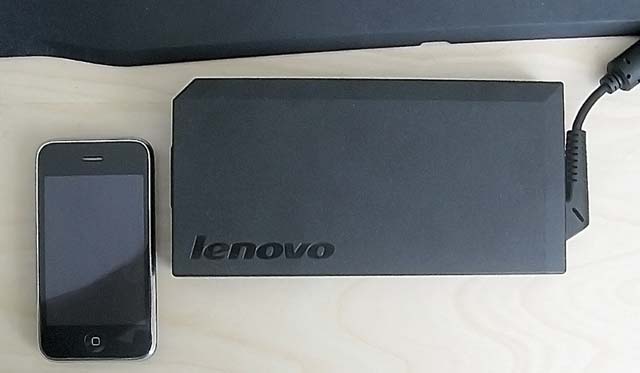
It’s clear that you don’t take this monster with you in any Las Vegas, you need to take something easier and simpler. On the other hand, if, for example, you go on a business trip where you need to work, you won’t drag the desktop with you in any situation, and you won’t get rid of the small X61s.
Speaking of travel. My frequent (if not constant) problem was the lack of an optical drive in the laptops that I usually ride with - for example, to watch highly-featured films. The standard Lenovo DVD-ROM / RAM was immediately replaced with an insert with a second hard drive for working data. With W701, this problem does not exist - it immediately provides two slots for 2.5-inch SATA drives - this is in addition to the DVD-RAM drive. Which, if pressed, can also be pulled out and replaced with a third disk. True, judging by everything, then the battery will last for an hour and a half, and this is with careful handling, but here it’s either checkers or go.
Now about the main thing - about the screen on the W701. 1920 by 1200, a 16: 9 ratio is not the most familiar combination after the T60p and its 1600x1200 and a 4: 3 ratio. I really do not see absolutely anything convenient in reducing the height of the display - the main scroll is always vertical for me - but judging by the many rumors, the matrix manufacturers are still able to bend laptop manufacturers, and not vice versa. However, the image quality does not suffer from this. In this situation, it makes no sense to bring any photos or screenshots, but I will say that in terms of quality it is almost IPS, only calibrated. Editing photos on it received aesthetic pleasure - much like playing a high-quality and well-tuned instrument.
I won’t talk about performance - almost all the tests I have seen do not reflect my own work scenarios. It’s always been strange for me personally to look at comparing the results of racing spherical horses in a vacuum and counting points in spherical parrots. I do not archive gigabytes of data with WinRAR. I very rarely recode videos from one format to another. And I almost never apply the same action once to the same picture in Photoshop. I can have one and a half to two dozen applications open - MS Outlook 2010, Chrome, Firefox (these three are constantly, with a bunch of tabs in both browsers), two DropBox, Skype, Trillian Astra, Word, Photoshop, FileZilla, UltraEdit, Visual Studio 2010, SQL Server Management Studio 2008, a couple of RDP connections, some VLC player or iTunes, or WinAmp, one or two virtual machines. All I want is that nothing sticks anywhere, hangs, brakes, tasks switch quickly, music or video does not slow down. So, W701 in this configuration meets my requests by 99%. The only gripe is the slow start of applications compared to SSDs. Yes, Adobe Photoshop CS5 does not fly, but it works smoothly and without delay - just stick the Seagate Momentus Hybrid (full name: Seagate Momentus XT ST95005620AS 500GB 7200 RPM 32MB Cache 2.5 "SATA 3.0Gb / s with NCQ Solid State Hybrid Drive) instead of a simple system Seagate, generally smooth operation is pleasing - regardless of the number of open applications, nothing shuts up anywhere, and if something swaps somewhere, it is very imperceptible.
Actually, here it is - the answer to the question "Why do I need a steam locomotive at home" - so that nothing would slow down. For comfortable and convenient work. In my opinion, Lenovo W701 is the right choice.
PS From local realities - Lenovo's technical support is very sane, and there are never any problems with a guarantee. On the next working day after calling tech support, I have a box under the door either for sending the laptop for repair, or a new part instead of the defective one.
